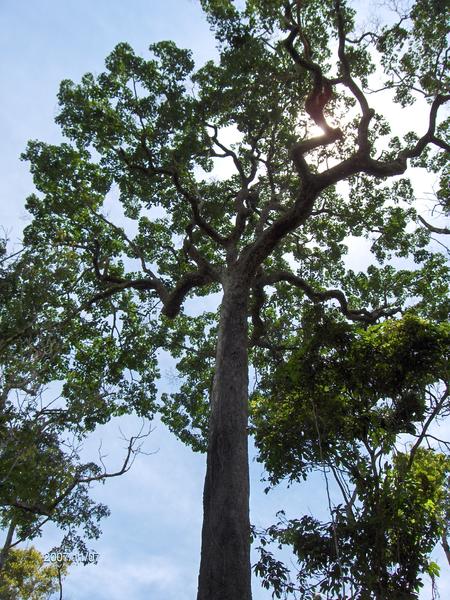Habitat and Geography
Habitat:
Bertholletia excelsa is an Amazonian tree that is found in over
five different countries throughout the northern portion of South America. Growing up to 200 feet tall, the B. excelsa tree
(right) is primarily
known to grow in non-flooding areas of the Amazonian lowland;
however, the trees can also be spotted in regions that are not as
densely covered by the massive forest, such as Venezuela and
Ecuador. The lowland areas of the Amazon provide sufficient
moisture for growth while having a more-limited threat of flooding
than other parts of the forest. The trees commonly grow in
groups, or clusters, of 50-100 individuals. In English, these
groups are called "stands," but they go by a variety of names; for
example, they are called “manchales” in Peru, and “castanhais”
in Brazil.
America. Growing up to 200 feet tall, the B. excelsa tree
(right) is primarily
known to grow in non-flooding areas of the Amazonian lowland;
however, the trees can also be spotted in regions that are not as
densely covered by the massive forest, such as Venezuela and
Ecuador. The lowland areas of the Amazon provide sufficient
moisture for growth while having a more-limited threat of flooding
than other parts of the forest. The trees commonly grow in
groups, or clusters, of 50-100 individuals. In English, these
groups are called "stands," but they go by a variety of names; for
example, they are called “manchales” in Peru, and “castanhais”
in Brazil.
The Amazon Rainforest is one of the most diverse habitats in the world, so the types of organisms that share this habitat with B. excelsa are nearly innumerable; however, the trees themselves can actually serve as a smaller habitats for some animals, such as birds and insects.
Geography:
B. excelsa is a very important organism
in South American culture because it not only serves as a
naturally abundant source of
.jpg) food, but it is also one of the
main economic exports in many of the countries it is native to.
Natural growth of B. excelsa takes place between
(approximately) latitudes 7° north and 10° south.
food, but it is also one of the
main economic exports in many of the countries it is native to.
Natural growth of B. excelsa takes place between
(approximately) latitudes 7° north and 10° south.
Even though B. excelsa is so economically important, the trees do not tend to grow outside of the Amazon Rainforest (left) or the surrounding areas. One reason for this lack of growth outside of the wild is the mutualistic relationship between B. excelsa and the orchid bee (see the Interactions page!). Efforts have been made to establish commercial plantations for B. excelsa, but the tree’s relationship with the orchid bee is the primary agent preventing any sort of expansion.
To learn more, continue to the Adaptation page!